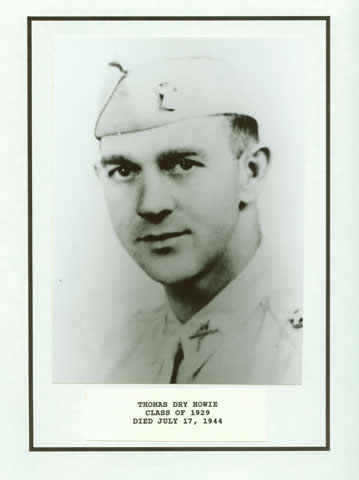Monuments
Major of St. Lo Memorial (Thomas Howie)- 116th Infantry, 29th Infantry Division
Major Thomas Howie Marker- 116th Infantry Regiment
29th and 35th Infantry Division Liberation of Saint Lô Memorial

Thomas Howie was born April 12, 1908 in Abbyville. South Carolina.
He is Immortalized as "The Major of St Lo" for his heroic exploits during the Normandy Campaign in World War II.
One of 7 children he was a star athlete in high school; at The Citadel he was an all state halfback on the football team and captain of the baseball team along with being a Rhodes Scholar finalist and President of the Senior Class (1929). After graduation he served as an English Teacher, Athletic Director and coach at Staunton Military Academy in Staunton, Virginia; he was commissioned into the Army Reserve after graduating from The Citadel and transferred to the Virginia National Guard in 1932 serving with the 116th Regiment of the 29th Division. Howie married Elizabeth Payne in 1932 and a daughter Sally was born in 1938. The 29th was activated in the summer of 1941 as the start of World War II became imminent, they trained at bases in Maryland, Virginia, North Carolina and Florida then sailed for England in September of 1942 where they continued to train for the eventual invasion of Europe. The 29th went ashore at Omaha Beach on June 6, 1944 with Major Howie serving as Operations Officer of the 116th Infantry, after breaking out from the beachhead and fighting through the hedgerow country of France they were poised to capture the strategic crossroads city of St. Lo. Howie was placed in command of the 3d Battalion of the 116th on July 13, 1944 and immediately was ordered to rescue the 2d Battalion which had been cut off and surrounded near the town of La Maddeleine, in hand to hand fighting they broke through in less than 2 hours territory that had held for days to rescue their comrades. Believing that his unit had earned the honor of liberating St Lo Howie radioed the commander of the 29th Division on the morning of July 16th, arguing that the 2d was too decimated saying "yes, we can do it" and then uttering the famous words "see you in St Lo!"; minutes later he was fatally wounded by a german mortar round. The following day as US forces entered St Lo Howies flag draped body was put on a stretcher which was placed on the hood of a jeep at the head of the American column so Howie could be the first soldier to enter the city, his men then ran through enemy fire to place the body in the rubble of the St Croix cathedral where local citizens placed flowers. Photos of this event were widely circulated in the US but due to wartime security Howies name could not be revealed so he was dubbed "The Major of St Lo" by a New York Times editor.
Howie has been honored by numerous memorials and tributes, Staunton Military Academy established a drill team called the Howie Rifles and his bust was placed outside the administration building. The citizens of St Lo erected a memorial to Howie and another was placed in his hometown of Abbeville. The Howie Bell Tower was erected next to the chapel at The Citadel in 1954 and his story was told in an episode of the TV show "Cavalcade of America" in 1956 as well as in an article written for Colliers Magazine by Cornelius Ryan. He was elected to the South Carolina Hall of Fame in 2003 and was the model for the character of Captain John Miller in the movie "Saving Private Ryan"
His best friend, Captin Sherman Victor Burroughs, also assigned to the 116th Infantry, was killed on D-Day on Omaha Beach on June 6, 1944.
Source: Find a grave
